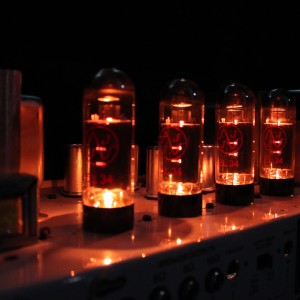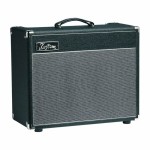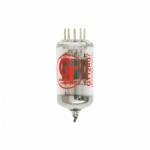Language
Knowing When To Replace Your Amp Tubes
To keep your tube amplifier running at its best, it needs proper care and maintenance. One of the most common sources of trouble when it comes to these kinds of amps is tube problems. In this article, we take a look at few common problems, how to spot them, and how to tell when its time to replace your bulbs.
 Tone Characteristics Of Four Common Amp Tubes[/caption]
The other reason, and arguably the more important of the two, is tone. The tubes in your amplifier are not unlike the strings on your guitar; a fresh set will yield a noticeable effect on tone while using them more often (or more aggressively) will wear them out faster. This means if you tend to play loud or consistently push your amp, you will see a downgrade in tone until the tubes finally die out. The wear down and change in tone is very gradual and you most likely won’t notice any day to day difference until you put in a new set and (with the help of a technician) bias them accordingly. It is also good practice to change all of your tubes at once, so the wear on them remains equal. This will ensure you get a more even tone, plus, you’ll have backups in case you need one during a gig or practice session.
Tone Characteristics Of Four Common Amp Tubes[/caption]
The other reason, and arguably the more important of the two, is tone. The tubes in your amplifier are not unlike the strings on your guitar; a fresh set will yield a noticeable effect on tone while using them more often (or more aggressively) will wear them out faster. This means if you tend to play loud or consistently push your amp, you will see a downgrade in tone until the tubes finally die out. The wear down and change in tone is very gradual and you most likely won’t notice any day to day difference until you put in a new set and (with the help of a technician) bias them accordingly. It is also good practice to change all of your tubes at once, so the wear on them remains equal. This will ensure you get a more even tone, plus, you’ll have backups in case you need one during a gig or practice session.
 Great Tube Combo Amps Under $600[/caption]
[caption id="attachment_4360" align="alignleft" width="150"]
Great Tube Combo Amps Under $600[/caption]
[caption id="attachment_4360" align="alignleft" width="150"] Tube Amp Standby Switch Explained[/caption]
[caption id="attachment_5007" align="alignleft" width="150"]
Tube Amp Standby Switch Explained[/caption]
[caption id="attachment_5007" align="alignleft" width="150"] How To Properly Care For Your Tube Amp[/caption]
How To Properly Care For Your Tube Amp[/caption]
Why You Want To Change Your Tubes
There are two main reasons why amp tubes would need to be changed. The first reason is pretty straight forward – they burn out. Amplifier vacuum tubes do not have a set amount of lifespan before they burn out, so it can realistically happen at any time (although some factors can make them more prone). If any of your tubes fail, it is important to change them immediately as operating your amp while any burnt tubes remain can potentially damage the amplifier’s transformer. Some amps, such as the Marshall JCM900, features a built-in failsafe fuse that can indicate if you have a burnt out tube. [caption id="attachment_5376" align="alignright" width="203"] Tone Characteristics Of Four Common Amp Tubes[/caption]
The other reason, and arguably the more important of the two, is tone. The tubes in your amplifier are not unlike the strings on your guitar; a fresh set will yield a noticeable effect on tone while using them more often (or more aggressively) will wear them out faster. This means if you tend to play loud or consistently push your amp, you will see a downgrade in tone until the tubes finally die out. The wear down and change in tone is very gradual and you most likely won’t notice any day to day difference until you put in a new set and (with the help of a technician) bias them accordingly. It is also good practice to change all of your tubes at once, so the wear on them remains equal. This will ensure you get a more even tone, plus, you’ll have backups in case you need one during a gig or practice session.
Tone Characteristics Of Four Common Amp Tubes[/caption]
The other reason, and arguably the more important of the two, is tone. The tubes in your amplifier are not unlike the strings on your guitar; a fresh set will yield a noticeable effect on tone while using them more often (or more aggressively) will wear them out faster. This means if you tend to play loud or consistently push your amp, you will see a downgrade in tone until the tubes finally die out. The wear down and change in tone is very gradual and you most likely won’t notice any day to day difference until you put in a new set and (with the help of a technician) bias them accordingly. It is also good practice to change all of your tubes at once, so the wear on them remains equal. This will ensure you get a more even tone, plus, you’ll have backups in case you need one during a gig or practice session.
Dealing With Preamp Tube Noise And Hissing
If you’ve ever turned on your tube amp and heard a hissing or high end squealing sound, even with the no guitar plugged in, you’re probably suffering from a ‘microphonic’ preamp tube. It’s an all too common problem, but luckily, there’s an easy way to narrow down the culprit. First, make sure the amp is unplugged. Now, remove the back panel. Once that's done, you can turn the amp back on and wait until the tubes warm up. Then, grab a pencil and lightly tap each preamp tube. Listen for any loud crackling or ringing sound. Each will ring a bit, but any bad tube will be much noticeable. If that doesn't work, you can also simply swap out one tube at a time with a new one until you narrow down the defective tube. Unlike power amp tubes, preamp tubes don't require biasing so its okay to this yourself, just make sure you take all the necessary precautions.How To Spot A Worn Out Tube
The best way to know when your tubes should be replaced is by listening as there are a few common signs. First, if you begin to notice certain tonal changes such as a loss of high-end, little or no treble, or a muddy bottom end with no clarity. Hearing erratic changes in volume or excessive noise, such as the 'microphonic' hissing sound described above, is another sign. And finally, if your tube amp just doesn't work, you should change your tubes (and hope that's the only problem). Hopefully, the information in this article will come in handy the next time you find yourself dealing with tube amp problems. And if you ever need a fresh set, check out the link below to browse our entire selection of high-quality Groove Tube tubes!Groove Tubes Brand Page
If you have any questions regarding any purchase, don't hesitate to talk with one of our PAL pros by using the Chat With us dialogue box below!Your Turn to Sound Off!
How often do you replace your tubes?Let us know in the comment section below!
[caption id="attachment_5018" align="alignleft" width="150"] Great Tube Combo Amps Under $600[/caption]
[caption id="attachment_4360" align="alignleft" width="150"]
Great Tube Combo Amps Under $600[/caption]
[caption id="attachment_4360" align="alignleft" width="150"] Tube Amp Standby Switch Explained[/caption]
[caption id="attachment_5007" align="alignleft" width="150"]
Tube Amp Standby Switch Explained[/caption]
[caption id="attachment_5007" align="alignleft" width="150"] How To Properly Care For Your Tube Amp[/caption]
How To Properly Care For Your Tube Amp[/caption]

